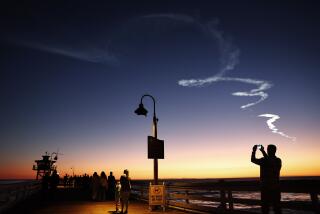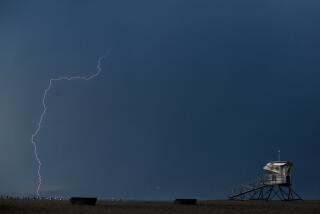Metal Flakes Cut Off Light Again, as They Coat Windows in La Jolla
- Share via
LA JOLLA — Retired architect George Lykos was doing yard work over the weekend when he glanced at the south-facing windows of his home here and noticed that there was something strange about the glass.
Little metal flakes--hundreds of them --had collected on the panes, leaving the clear glass a dull gray. But instead of reaching for a bottle of window cleaner, Lykos, 73, reached for the phone Monday morning and called the San Diego Gas & Electric Co.
His discovery and those of a handful of other SDG&E; customers this weekend may provide company officials with evidence to prove their allegations that Navy aircraft inadvertently caused a widespread power outage in San Diego on Thursday while dropping anti-radar material over the Pacific Ocean.
While they have initiated an investigation of the incident, Navy officials have disputed SDG&E;’s assertions that the airborne drill was responsible for the three-hour power failure. The Navy’s exercise, conducted 100 to 300 miles southwest of San Diego, resulted in a 50-mile-wide cloud of tiny, non-toxic particles called “chaff” drifting over the San Diego area on winds that had not been forecast.
Federal Aviation Administration air traffic controllers tracked the wind-blown cloud on their radar screens. However, despite intensive searching, SDG&E; workers were unable to find any of the composite aluminum-fiberglass particles near the company’s transmission equipment, which short-circuited before and during Thursday’s rolling blackout.
But during the weekend and on Monday, SDG&E; received half a dozen telephone calls from customers in La Jolla and in the beach areas saying they had found what they thought was chaff, according to company spokesman Dave Smith. The descriptions provided by three of the callers, including Lykos, seemed valid enough to dispatch crews to investigate, Smith said.
Technicians collected samples from each of the callers and planned to analyze them.
“Until we know what the material is, we really can’t say much about it,” Smith said. “If it proves to be (chaff), it will confirm what we already suspected has occurred.”
SDG&E; spokeswoman Elizabeth Abbott said the company also is trying to obtain some of the material the Navy used for its radar tests to see if the two are the same. The particles SDG&E; collected “appear to be like fiberglass,” she said, but final results will not be available before Wednesday or Thursday.
Smith said SDG&E; has scheduled meetings this week with ranking Navy commanders to review Thursday’s incident and “to make sure it doesn’t happen again.” The blackout cut power to 65,000 homes and businesses, snarled traffic and was blamed for at least one minor car crash.
Navy spokesmen on Monday declined to discuss any aspect of last week’s power outage except to say that an investigation by ranking naval commanders was continuing.
Lykos said it was within hours after power was restored to his Paseo Dorado home that he noticed things weren’t quite right with the expansive windows on the south side of the house.
While working outside on Sunday, Lykos again noticed the windows’ lackluster appearance and decided to examine the glass more closely.
“I got out my magnifying glass and then it hit,” he said. “I knew that it was definitely the Navy’s stuff that everybody was looking for.”
Lykos then compared notes with a neighbor, who had found similar particles not only on the windows of her home, but also on the windshield of her car.
More to Read
Inside the business of entertainment
The Wide Shot brings you news, analysis and insights on everything from streaming wars to production — and what it all means for the future.
You may occasionally receive promotional content from the Los Angeles Times.










